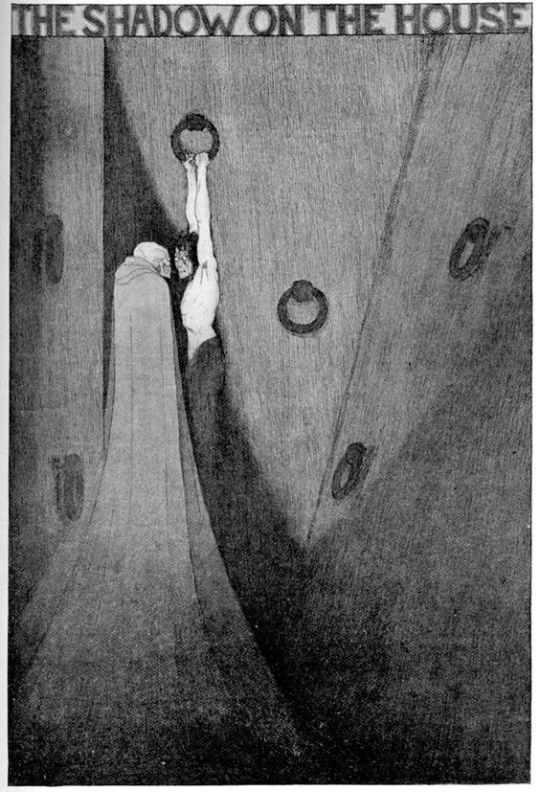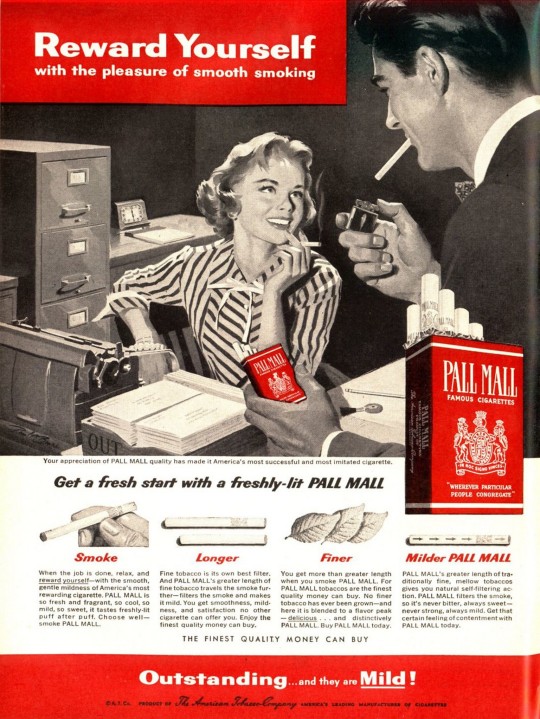#Pall Mall Magazine
Explore tagged Tumblr posts
Text

Patten Wilson (1869-1934), ''The Pall Mall Magazine'', Vol. 38, 1906 Source
52 notes
·
View notes
Text

Sidney H. Sime - The shadow on the house. Illustration from Pall Mall Magazine, 1906.
13 notes
·
View notes
Video
1937 illustration by Charles ‘Clixby’ Watson by totallymystified Via Flickr: For the story It’s An Ill Wind by Alice Hegan Rice. From Nash’s Pall Mall Magazine.
#Charles Clixby Watson#Clixby Watson#artist#illustrator#Alice Hegan Rice#Its An Ill Wind#Pall Mall Magazine#Nash's#illustration#1937#1930s#30s#thirties#flickr
0 notes
Text

10 notes
·
View notes
Text

1965 Pall Mall Cigarettes
#1965#pall mall#cigarettes#smoking#vintage tobacco#imaynotdrinkbutiknowwhatilike#vintage advertising#vintage magazine#magazine#vintageadsmakemehappy#advertising#60s advertising#1960s ad
24 notes
·
View notes
Text
London's First Department Store
The story of Harding, Howell & Co, London's first #department store @Countrylifemag https://www.countrylife.co.uk/luxury/style/curious-questions-who-opened-the-first-ever-department-store-254207
The story of London’s first department store and the man whose vision it was. To read the article in full, follow the link below: Who opened the first ever department store?

View On WordPress
0 notes
Text
Oingo Boingo - Dead Man's Party 1986
"Dead Man's Party" is a song by American band Oingo Boingo, released as the third single from their fifth studio album of the same name. The song was released on a 12" single in conjunction with another song from the album, "Stay". It is perhaps best known for its appearance in the 1986 film Back to School, where the band performed it at a party.
The lyric, "I hear the chauffeur coming to my door/Says there's room for maybe just one more," is a reference to "The Bus-Conductor," a short story by E. F. Benson about a hearse driver, first published in The Pall Mall Magazine in 1906. The story has been adapted several times and spawned an urban legend, with each version using the catchphrase, "Room for one more".
Danny Elfman performed the song as the final encore of his Nightmare Before Christmas concerts at the Hollywood Bowl in 2015, 2016, and 2018, and at Banc of California Stadium in 2021, alongside his former Oingo Boingo guitarist and arranger Steve Bartek.
"Dead Man's Party" received a total of 80,9% yes votes! Previous Danny Elfman polls: #5 "This Is Halloween".
youtube
667 notes
·
View notes
Text
Stop doing what you're doing right now and go cancel a subscription. Chances are you're inadvertently donating money every month to a political party, long-dormant print magazine, streaming service, doomsday cult, or predatory mega-corporation. You are gaining literally no benefit from it. You probably forgot you even had it set up. That money could be spent better elsewhere, by cramming it into the mouth of your local weirdos.
All around you are folks trying to make something very strange. Maybe they're electrical engineers who are trying to build this thing they saw in their dreams, the humming menace that destroys the earth. Perhaps they're just some local artist working hard to make a mug that looks a whole lot like a cat's butthole. No matter what, you can afford to support these folks financially by simply reaching out and cancelling a recurring payment to some group of faceless assholes.
Conversely, those faceless assholes love subscriptions, for the precise reason you may have already guessed. People forget to stop paying them. Or, more likely, they've made it a huge pain in the ass to stop paying them. Don't worry. Here at Seat Safety Switch's Subscription Scam Scancellers (we couldn't come up with a good synonym, and Ted in accounting kept pushing really hard for "ceasers" without realizing that's A: not a word, and B: doesn't start with S) our job is to make sure that you get your five to nineteen dollars a month back in your pocket.
How do we do it? With machine learning, you ask? Take your R2D2 fetish somewhere else, freak. No, we do it the old fashioned way: by hiring people who are too salty to work anywhere else. Half of our employees are former stevedores and union electricians who got fired for swearing too much at work. They will absolutely not take "no" for an answer, and sitting all day on the phone yelling at customer service robots while they burn through a pack of Pall Malls and a flat of malt liquor is essentially a holiday for them.
So call on us today, and we'll get you hooked up. Of course, to get the best service, you'll need to be part of our "Premium Club," which involves a small payment of only $7.50 a month. Your first three months are reduced to $3.60 a month! You can cancel anytime you figure out how to.
588 notes
·
View notes
Text

Illustration by Aubrey Beardsley for the Pall Mall Magazine, June 1893.
14 notes
·
View notes
Text

This month in 1906 the E.F. Benson story The Bus-Conductor was published in Pall Mall Magazine. It's one of the earliest appearances of the urban legend Room For One More?
The story goes like this: a traveler is staying the night at a friend’s house. Shortly after midnight, a sound from outside brings them to the window. On the driveway below, the traveler sees a hearse pull up. There is no coffin inside, but instead a group of living people. The hearse driver, a man with a sinister appearance, looks up at the traveler in the window and says, “There’s room for one more.”
Shaken, the traveler returns to bed, and in the morning, dismisses the creepy encounter as a dream. But later that day the traveler goes to board a bus, and finds the driver looks exactly like the hearse-driver from the night before. And he repeats his invitation— “There’s room for one more.”
Terrified, the traveler backs away from the bus, letting it leave without them. A moment later, a truck slams into the bus, killing everyone on board.
Read all about it on my blog, and get writing prompts, such as:
Destination unknown. The story always ends with a crash. But there are other potentially horrifying fates. Perhaps the bus is hijacked, or takes a wrong turn down a foggy road and never arrives at its next stop. Maybe the elevator reaches the first floor unscathed, but with all its passengers vanished. Could it have opened at floor 13, which everyone thinks does not exist?
DannyeChase.com ~ AO3 ~ Linktree ~ Weird Wednesday writing prompts blog ~ Resources for Writers
Image credit
#Dannye writes#writing inspiration#writing prompts#writing#writers on tumblr#writeblr#writeblogging#writing community#Weird Wednesday blog#blogging#scifi prompt#fantasy prompt#horror prompt#room for one more#urban legend
9 notes
·
View notes
Photo

“Guesses at Futurity No. 7: Interplanetary Communication. Gold Mining in the Mountains of the Moon” from the Pall Mall Magazine, 1895
29 notes
·
View notes
Text

Nash's and Pall Mall magazine, Sept. 1922.
24 notes
·
View notes
Text

1956 Reward Yourself with the pleasure of smooth smoking. Pall Mall
Source: Time Magazine
Published at: https://posterhistory.com/smoking/pall-mall/
17 notes
·
View notes
Video
1937 illustration by Charles ‘Clixby’ Watson by totallymystified Via Flickr: For the story It’s An Ill Wind by Alice Hegan Rice. From Nash’s Pall Mall Magazine.
#Charles Clixby Watson#Clixby Watson#artist#illustrator#Alice Hegan Rice#Its An Ill Wind#Pall Mall Magazine#Nash's#illustration#1937#1930s#30s#thirties#flickr
0 notes
Text

Arthur Rackham — 34 Children and a Queen (1891)
“Fantastic pen and ink piece by master illustrator Arthur Rackham, published in Pall Mall magazine (London) in 1891, in celebration of the birth of Queen Victoria’s 34th grandchild, and representing the Queen as the Old Woman in the Shoe. This is an early Rackham, drawn when he was just 24 years old. During this period, Rackham was illustrating for many of the English magazines of the day. It would be another three years before Rackham would start illustrating books and developing the techniques and style that made him a household name and arguably the greatest children’s book illustrator who ever lived. That said, you can see Rackham’s early brilliance in this piece — great linework, imagery, and whimsy.”
Source
3 notes
·
View notes
Text

1951 Pall Mall Cigarette advertising
#1951#pall mall#Cigarette#smoking#tobacco#vintage tobacco#imaynotdrinkbutiknowwhatilike#vintage advertising#vintage magazine#magazine#vintageadsmakemehappy#advertising#1950s#50s#50s ads
19 notes
·
View notes

